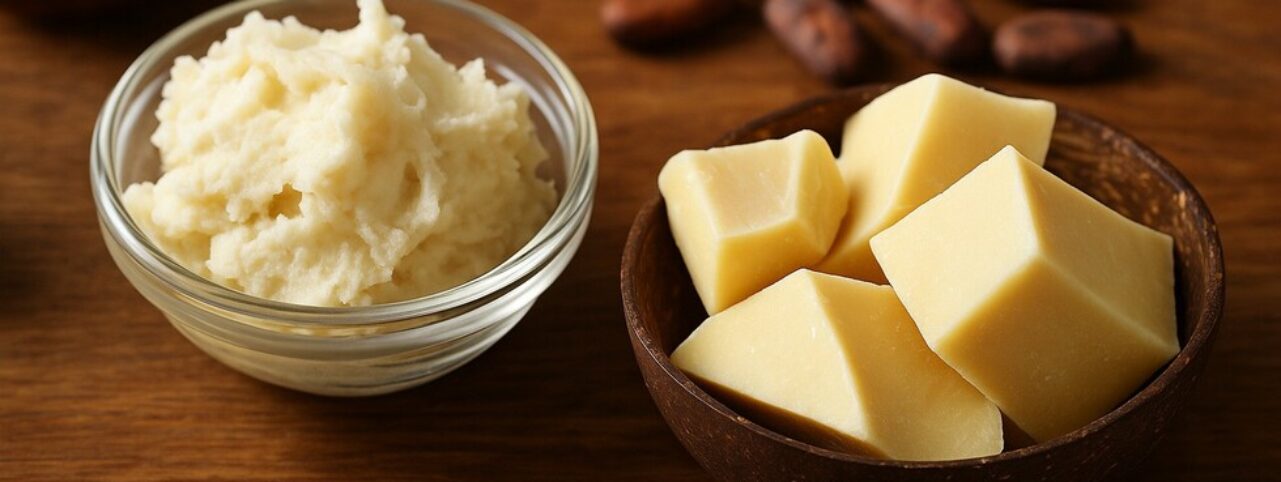Error: Contact form not found.

When it comes to natural skincare, Shea butter and Cocoa butter are two of the most revered ingredients on the market. Found in a wide range of beauty products—from lotions and lip balms to body butters and baby creams—both these plant-derived fats are known for their rich texture and deep moisturizing abilities.
But with such similar reputations, how do you know which one is right for your skin? This blog breaks down the differences, benefits, and ideal use cases of Shea butter and Cocoa butter to help you decide which one deserves a spot in your skincare routine.
Shea butter is extracted from the nuts of the Shea tree (Vitellaria paradoxa), native to West Africa. It is ivory or off-white in color and has a creamy consistency that melts upon contact with the skin.
Shea butter is rich in fatty acids like oleic, stearic, palmitic, and linoleic acids, as well as vitamins A, E, and F, which contribute to its healing and moisturizing properties.
Cocoa butter, on the other hand, comes from the cocoa bean (Theobroma cacao), the same bean used to make chocolate. It is typically pale yellow and has a firmer texture compared to Shea butter.
Cocoa butter is high in saturated fats, particularly stearic and palmitic acids, and is also packed with polyphenols that offer antioxidant and anti-inflammatory benefits.
If you’re sensitive to strong scents, Shea butter may be more suitable. If you love the smell of chocolate, Cocoa butter will feel like a treat.
Both Shea and Cocoa butter offer intensive hydration, but the way they work is slightly different.
Winner: If you want a fast-absorbing hydrator, Shea butter wins. For long-lasting protection, Cocoa butter takes the lead.
Both butters are known for their healing abilities, but they shine in slightly different ways.
Contains lupeol and cinnamic acid—natural compounds that reduce inflammation
Promotes healing for:
Rich in polyphenols, which help reduce inflammation and free radical damage
Popular for scar and stretch mark prevention, especially during pregnancy
Winner: Shea butter may have broader applications for skin conditions due to its anti-inflammatory and soothing properties.
| Nutrient/Property | Shea Butter | Cocoa Butter |
|---|---|---|
| Vitamin A | ✅ Yes | ❌ Minimal |
| Vitamin E | ✅ Yes | ✅ Yes |
| Antioxidants | ✅ Good | ✅ High |
| Fatty Acids | ✅ Balanced | ✅ High |
| Anti-Inflammatory | ✅ Strong | ✅ Moderate |
Shea butter offers more nutrients that nourish and repair the skin, while cocoa butter excels at shielding and moisturizing.
Sensitive or irritated skin
Babies and toddlers
Face moisturizers
Eczema, dermatitis, or psoriasis
Soothing sunburn or insect bites
Preventing stretch marks
Healing dry, cracked skin (heels, elbows)
Lip balms and body butters
Deep winter hydration
Rich nighttime moisturizers
Tip: For areas prone to dryness and friction (like elbows or belly during pregnancy), Cocoa butter works best. For calming inflamed or irritated skin, opt for Shea.
| Skin Type | Recommended Butter |
|---|---|
| Oily Skin | Shea Butter |
| Dry Skin | Cocoa Butter |
| Sensitive Skin | Shea Butter |
| Mature Skin | Both (combo is ideal) |
| Combination Skin | Shea for face, Cocoa for body |
Shea Butter: Typically lasts 12–24 months. Store in a cool, dark place.
Cocoa Butter: Longer shelf life—up to 2–5 years, due to its antioxidant content.
Note: Both butters should be stored in airtight containers away from direct sunlight.
Absolutely! In fact, many skincare products combine Shea and Cocoa butter to balance texture and benefits. This dual approach gives you:
DIY enthusiasts often blend them with essential oils (like lavender, frankincense, or rosehip) for custom body butters or healing balms.
While it’s heavier, it doesn’t automatically clog pores if used appropriately. Avoid on acne-prone areas like the face.
Pure, unrefined Shea butter is non-comedogenic (doesn’t block pores) and safe for most skin types.
Not true. Each has unique strengths—choosing the right one depends on your skin’s needs and personal preferences.
It all comes down to your skin goals and personal preferences:
Both are powerful, natural solutions that can elevate your skincare routine when used correctly. For best results, consider using Shea butter for the face and Cocoa butter for the body, or alternate them seasonally—Shea in summer, Cocoa in winter.
Always choose:
Raw or unrefined versions for maximum nutrients
Fair trade or organic certification for ethical sourcing
Products without added fragrances, parabens, or silicones
In the end, Shea and Cocoa butters aren’t competitors—they’re companions. Depending on your skin type and goals, using both in tandem might just be the best approach to healthy, radiant skin.